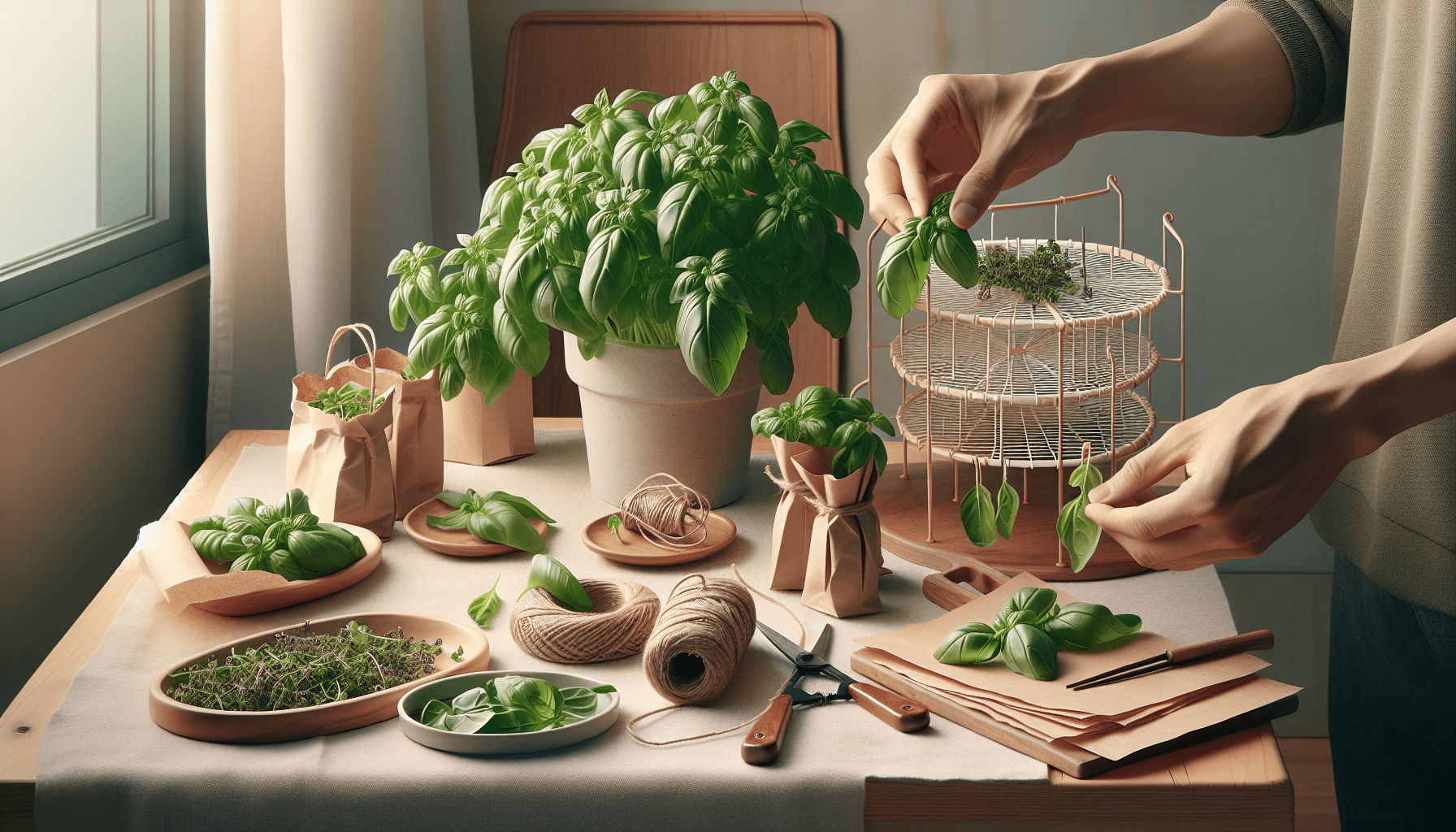So, you’ve just picked some fresh basil from your herb garden and you’re wondering what to do with it all. Well, fear not! This beginner’s guide will teach you everything you need to know about drying basil, ensuring that you can enjoy the herb’s delightful flavors and aromas even during the off-season. From the various drying methods to tips on storing and using dried basil, this article has got you covered. So grab a bunch of basil and let’s get started on preserving its incredible taste and fragrance for months to come.

Choosing and Harvesting Basil
Selecting the Right Basil
When it comes to choosing basil for drying, you want to make sure you pick the right variety. Sweet basil is the most common type used for cooking and drying, but there are also other varieties such as lemon basil and purple basil that can add unique flavors and colors to your dishes. Take some time to explore different types of basil and choose the one that appeals to your taste buds.
When to Harvest Basil
The best time to harvest basil is in the morning, after the dew has dried but before the sun gets too hot. This is when the leaves contain the highest concentration of essential oils, which contribute to its aroma and flavor. Be sure to wait until your basil plant has reached a height of at least 6 inches before harvesting to allow for optimal growth.
How to Harvest Basil
To harvest basil, simply pinch the leaves off the plant with your fingers or use a pair of scissors for a clean cut. Start by harvesting the larger, outer leaves first, leaving the smaller ones in the center to continue growing. This will allow the plant to continue producing more leaves throughout the season. Remember to be gentle when harvesting to avoid damaging the plant.
Preparing Basil for Drying
Washing Basil Leaves
Before drying basil, it’s important to wash the leaves to remove any dirt or debris. Fill a bowl or sink with cool water and gently place the basil leaves in it. Swirl them around to loosen any dirt, then remove them from the water and pat them dry with a clean towel.
Removing Excess Moisture
To ensure that your basil dries properly, it’s crucial to remove any excess moisture. Lay the washed basil leaves on a clean towel and gently blot them to absorb the water. Alternatively, you can use a salad spinner to quickly and effectively remove the moisture from the leaves.
Trimming and Storing Basil Leaves
Once the basil leaves are washed and dried, it’s time to trim them. Remove any damaged or discolored parts of the leaves, as these can affect the quality of the dried basil. Next, decide whether you want to dry the whole leaves or chop them into smaller pieces. If you choose to chop them, use a sharp knife or kitchen scissors to achieve your desired size. Store the trimmed basil leaves in an airtight container until you’re ready to move on to the drying process.
Drying Methods for Basil
Air Drying
Air drying is one of the simplest and most traditional methods of drying basil. It requires minimal equipment and relies on the natural airflow to slowly remove moisture from the leaves. This method is ideal for those who prefer a more hands-off approach to herb drying.
Oven Drying
If you’re looking for a quicker drying method, oven drying is a great option. It requires a bit more attention and specific temperature settings but can significantly reduce drying time compared to air drying. Oven drying is perfect for those who need dried basil in a shorter amount of time.
Using a Dehydrator
Using a dehydrator is the most efficient and controlled method for drying basil. Dehydrators are designed to gently and evenly remove moisture from herbs, resulting in perfectly dried and preserved leaves. This method is especially useful if you plan on drying large quantities of basil or if you want more consistent results.
Air Drying Basil
Gathering Basil Bunches
To air dry basil, gather a few stems of basil together to form a small bunch. Secure the stems together with a rubber band or twine. It’s important not to make the bunches too large, as too many leaves clustered together can prevent proper airflow, leading to uneven drying.
Hanging Basil to Dry
Once you have your basil bunches prepared, find a warm, dry, and well-ventilated area to hang them. You can use hooks, clothespins, or string to suspend the bunches upside down from a ceiling, a drying rack, or a rod. This position allows for maximum airflow around the leaves, aiding in the drying process.
Drying Time and Conditions
The drying time for air drying basil can vary depending on various factors such as humidity, temperature, and the thickness of the leaves. Typically, basil will take about 1 to 2 weeks to dry completely. Keep an eye on the leaves and check for crispness. Once they crumble easily between your fingers, your basil is ready to be stored.
Oven Drying Basil
Preheating the Oven
Before oven drying basil, preheat your oven to the lowest temperature setting available. Ideally, the temperature should be around 140°F (60°C) to 170°F (77°C). It’s important not to set the temperature too high, as it can cause the basil to brown or lose its flavor.
Preparing Basil for Oven Drying
To prepare basil for oven drying, place the trimmed leaves on a baking sheet lined with parchment paper. Make sure the leaves are spread out in a single layer, without overlapping. This allows for even heat distribution and ensures that each leaf dries uniformly.
Oven Drying Time and Temperature
Place the baking sheet with the basil leaves in the preheated oven and leave the door slightly ajar to allow moisture to escape. Check on the leaves periodically, as drying times can vary between 45 minutes to 2 hours. When the leaves are dry and crumbly to the touch, remove them from the oven and let them cool completely before storing.
Using a Dehydrator to Dry Basil
Preparing Basil for Dehydration
To prepare basil for dehydration, spread the trimmed leaves evenly across the dehydrator trays. Make sure there is enough space between the leaves to promote proper airflow. This will ensure that the basil dries evenly and prevents the growth of mold or mildew.
Setting up the Dehydrator
Once the basil is arranged on the trays, place them in the dehydrator according to the manufacturer’s instructions. Set the dehydrator temperature to around 95°F (35°C) to 125°F (52°C) and leave it running for approximately 2 to 4 hours. Keep an eye on the basil to prevent over-drying.
Dehydrating Time and Temperature
The drying time for basil in a dehydrator will depend on the thickness of the leaves and the specific model of the dehydrator. Check the basil periodically, and when the leaves are brittle and crumble easily, they are ready to be removed. Allow the basil to cool before transferring it to storage containers.
Storing Dried Basil
Removing Dried Basil from Stems
Once your basil is completely dried, it’s time to remove the leaves from the stems. Gently crumble or strip the leaves off the stems, discarding any parts that may not have dried completely or are too tough. Be careful not to crush the leaves too much, as this can diminish their potency.
Crushing or Grinding Dried Basil
To maximize the flavor and aroma of dried basil, you can crush or grind the leaves right before using them. This helps release the essential oils and intensifies the taste. Use a mortar and pestle or a spice grinder to crush the basil leaves into a fine powder or a coarse texture, depending on your preference.
Proper Storage Containers
To preserve the quality of the dried basil, store it in airtight containers made of glass, metal, or plastic. Make sure the containers are clean and dry before adding the basil. Store the containers in a cool, dark place, away from direct sunlight, which can deteriorate the flavor and color of the herb. Properly stored dried basil can last for up to a year.
Using Dried Basil
Substituting Dried Basil for Fresh Basil
When using dried basil as a substitute for fresh basil in recipes, remember that dried herbs are more concentrated in flavor. As a general rule, you can use approximately one-third the amount of dried basil in place of fresh basil. However, it’s always best to taste and adjust the seasoning according to your preferences.
Rehydrating Dried Basil
If you prefer to rehydrate dried basil before using it, simply place the desired amount of dried basil in a small bowl and cover it with warm water. Let it sit for a few minutes until the leaves absorb the moisture and become pliable. Drain any excess water before incorporating the rehydrated basil into your recipes.
Recipes and Ideas for Using Dried Basil
Dried basil can be used in a wide variety of dishes, including soups, stews, marinades, sauces, and even baked goods. It pairs well with tomatoes, garlic, citrus flavors, and other herbs such as oregano and thyme. Sprinkle it over pizzas, pasta dishes, or roasted vegetables for an added burst of flavor. Get creative and experiment with different recipes to discover new ways to use dried basil in your kitchen.
Additional Tips and Tricks
Preserving Basil Aroma and Flavor
To preserve the aroma and flavor of dried basil, store it away from strong-smelling spices or ingredients. Basil can easily absorb odors, so it’s best to keep it in a separate container to maintain its distinct taste. Also, try to use freshly dried basil within the first six months to ensure maximum freshness.
Benefits of Drying Basil
Drying basil not only extends its shelf life but also concentrates its flavor and aroma. The potent dried herb can be a convenient alternative when fresh basil is not readily available. Dried basil can be stored for an extended period, allowing you to enjoy its delightful taste and fragrance in your recipes throughout the year.
When to Replace Dried Basil
Over time, the flavor and aroma of dried basil will gradually diminish. If you notice that your dried basil has lost its potency or has an off smell, it’s time to replace it. Using fresh, high-quality dried basil ensures that you’ll always have a vibrant and flavorful herb to enhance your culinary creations.
Conclusion
By choosing the right basil, harvesting it at the optimal time, and properly drying and storing it, you can enjoy the delightfully aromatic and flavorful benefits of dried basil. Whether you prefer the traditional air drying method, the quicker oven drying technique, or the convenient dehydrator option, there’s a drying method that suits your needs. Experiment with different recipes and ideas to make the most of your home-dried basil, and enjoy the flavors it adds to your favorite dishes. Happy drying!

